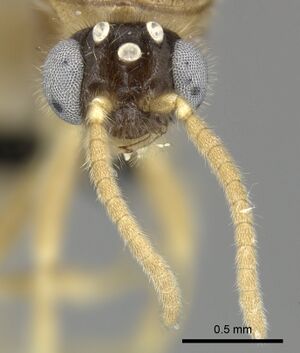Adetomyrma cilium
| Adetomyrma cilium | |
|---|---|

| |
| Scientific classification | |
| Kingdom: | Animalia |
| Phylum: | Arthropoda |
| Class: | Insecta |
| Order: | Hymenoptera |
| Family: | Formicidae |
| Subfamily: | Amblyoponinae |
| Tribe: | Amblyoponini |
| Genus: | Adetomyrma |
| Species: | A. cilium |
| Binomial name | |
| Adetomyrma cilium Yoshimura & Fisher, 2012 | |
Known from a small number of males from two localities. The specimens were collected with a malaise trap and in a pitfall trap.
Identification
Yoshimura and Fisher (2012) - The male of A. cilium is distinguished easily from the other Adetomyrma males by a combination of long hairs on the eye, long suberect hairs on the anterior surface of the mesofemur, and a well-developed subpetiolar process.
Adetomyrma cilium is relatively similar to Adetomyrma clarivida. We regard these two as different species because of consistent differences in the mesofemur hairs and development of the subpetiolar process. Additionally, these species differ in the shape of the aedeagus and the palpal formula.
Keys including this Species
Distribution
Latitudinal Distribution Pattern
Latitudinal Range: -19.006727° to -24.77305556°.
| North Temperate |
North Subtropical |
Tropical | South Subtropical |
South Temperate |
- Source: AntMaps
Distribution based on Regional Taxon Lists
Malagasy Region: Madagascar (type locality).
Distribution based on AntMaps
Distribution based on AntWeb specimens
Check data from AntWeb
Countries Occupied
| Number of countries occupied by this species based on AntWiki Regional Taxon Lists. In general, fewer countries occupied indicates a narrower range, while more countries indicates a more widespread species. |

|
Estimated Abundance
| Relative abundance based on number of AntMaps records per species (this species within the purple bar). Fewer records (to the left) indicates a less abundant/encountered species while more records (to the right) indicates more abundant/encountered species. |

|
Biology
Castes
Male
Images from AntWeb
  
| |
| Paratype of Adetomyrma cilium. Male (alate). Specimen code casent0007089. Photographer Ryan Perry, uploaded by California Academy of Sciences. | Owned by NHMUK, London, UK. |
Nomenclature
The following information is derived from Barry Bolton's Online Catalogue of the Ants of the World.
- cilium. Adetomyrma cilium Yoshimura & Fisher, 2012b: 20, figs. 26, 27, 34, 43, 52, 60, 69 (m.) MADAGASCAR.
- Type-material: holotype male, 3 paratype males.
- Type-locality: holotype Madagascar: Toliara, Parc Nat. d’Andohahela, Col du Sedro, 3.8 km. 113° ESE Mahamavo, 37.6 km. 341° NNW Tolagnaro, 24°28.44.83’S, 46°45.1’E, 900 m., 21-25.i.2002, BLF05009, montane rainforest, Malaise trap (Fisher-Griswold Arthropod Team); paratypes: 2 males with same data, 1 male with same data but 21-25.i.2002, BLF05013.
- Type-depositories: CASC (holotype); BMNH, CASC, MHNG (paratypes).
- Distribution: Madagascar.
Unless otherwise noted the text for the remainder of this section is reported from the publication that includes the original description.
Description
Male
Measurements: holotype. HL 0.65, HW 0.88, SL 0.2, EL 0.46, WL 1.62, MnW 0.98, CI 134, SI 22.9, EI 71.1, MnI 112.2.
HL 0.61–0.65, HW 0.86–0.96, SL 0.19–0.21, EL 0.44–0.5, WL 1.48–1.71, MnW 0.88–1.08, CI 136.7–147.6, SI 21.3–22.5, EI 72.5–76.7, MnI 102.2–117.8 (3 paratypes and 1 individual measured).
Eye well developed and prominent, its posterior margin not exceeding posterior margin of mid ocellus in full-face view. Distance between lateral ocellus and eye varies from equal to or shorter than diameter of lateral ocellus, but always longer than 0.5X diameter of lateral ocellus. Palpal formula 2,3 (two maxillary and three labial). Notaulus absent on mesoscutum. Parapsidal line clearly impressed. Anterior margin of petiole longer than dorsal margin in lateral view. Subpetiolar process developed, but presence of hairs on process variable.
Left and right parameres not overlapping or narrowly overlapping on dorsal small part of basimere. No distinct projection or lobe present on posterodorsal portion of paramere. Basal ring not reduced, covering whole anterior margin of paramere in lateral view. Basal projection on cuspis clear but not extraordinarily well developed. Aedeagus in lateral view slightly and gradually narrowed from ventral projection; apical margin relatively sharp, with a small, broadly triangular projection on posteroventral portion; posteroventral margin of ventral projection concave.
Hairs on compound eyes long, as long as or longer than diameter of mid ocellus. Mesofemur in dorsal view, anterior face with dense subdecumbent and many long suberect hairs. Ventral margin of eye not edged with darker pigment or punctures. Body bicolored, head brown and remainder yellow.
Type Material
Holotype. Male: CASENT0007808, BLF05009: MADAGASCAR, Toliara, Parc National d'Andohahela, Col du Sedro, 3.8 km 113° ESE Mahamavo, 37.6 km 341° NNW Tolagnaro, 24° 45.83´ S, 46° 45.1´ E, 900 m alt., montane rainforest, Malaise trap, 21–25.i.2002, Fisher-Griswold Arthropod Team leg. California Academy of Sciences. Paratypes. 2 males: CASENT0007089 The Natural History Museum, CASENT0227987 Musee d'Histoire Naturelle Genève, with same data as holotype; 1 male: CASENT0007096, BLF05013: same locality as holotype, pitfall trap, 21–25.i.2002, Fisher-Griswold Arthropod Team leg. [CASC]
Etymology
This species name is derived from the Latin word cilium (eyelash), and refers to the long hairs on its compound eye. The species epithet is treated as a noun in apposition, and thus invariant.
Determination Clarifications
This new species corresponds to the following species code used in previous studies: mgm04: Yoshimura & Fisher 2012.
References
- Cantone S. 2017. Winged Ants, The Male, Dichotomous key to genera of winged male ants in the World, Behavioral ecology of mating flight (self-published).
- Yoshimura, M. & Fisher, B.L. 2012. A revision of the Malagasy endemic genus Adetomyrma (Hymenoptera: Formicidae: Amblyoponinae). Zootaxa, 3341, 1-31.
References based on Global Ant Biodiversity Informatics
- Yoshimura M., B.L. Fisher. 2012. A revision of the Malagasy endemic genus Adetomyrma (Hymenoptera: Formicidae: Amblyoponinae). Zootaxa 3341: 1-31.

